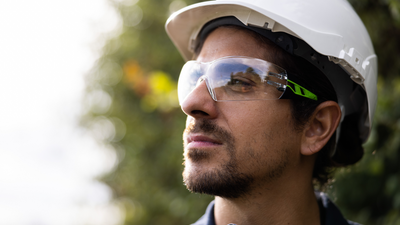Storage and Handling
Transporting and Handling of Cylinders
Trolley
Inside the plant, cylinders must be moved using appropriate trollies to which the cylinders are fastened. A cylinder must never be dragged or rolled on its side on the ground. If cylinders must be moved to upper stories, the service elevator must be used. Never pick up cylinders by the cap or valve. Never drop a cylinder on the ground. Before taking a cylinder from the Gas Store, make sure there is no leak at the collar and that the valve is sealed tight. Keep the cap on the cylinder whenever it is being transported and handled. Never move a cylinder that contains a toxic gas without making sure it is equipped with its safety plug and protective cap.
Personal Gear
The personnel responsible for handling cylinders must be equipped with protective footgear and gloves.
Impact
Cylinders must not be subjected to treatment liable to decrease their resistance: electric arc, violent blow, etc. Report any problem to Air Liquide, which will take the cylinder back.
Cylinders in Use: The Distribution Station
Capacity
Suit the capacity of the cylinder to your needs.
Location
To the extent possible, place cylinders outside workshops or laboratories and on the ground floor. If distribution stations must be set up in buildings, it is a good idea to concentrate cylinders of flammable and toxic gases in stations equipped with extractor hoods and special gas detectors.
Fastening
Any cylinder in use must be secured by a metal chain to keep it from falling over
Turning the Valve
The only way to open valves is a little at a time; never use force. If a valve cannot be opened by hand, return it to the supplier. Never try to open it using force (wrenches, etc.). Never use force on a valve to close it.
Heating - cooling
Never heat a cylinder that contains a liquefied gas to increase the gas flow; to increase the required rate, connect several cylinders in parallel or consult your gas supplier.
Connectors
Use only connectors provided by your supplier. It is forbidden to use intermediate connections. Check the condition of couplings before use. If a coupling is worn or altered, replace it with a new one. Use only materials compatible with the gas.
Emergency Equipment
Provide operators with emergency equipment appropriate to the potential risks: footgear, gloves, mask, wetsuit, respirator, etc.
Foreign Body in Cylinder
It is always dangerous to allow any substance whatsoever (gas or liquid) to get into a cylinder that is being used. If there is a risk of this, mount a check valve. If a foreign substance accidentally gets into a cylinder, notify us.
Empty Cylinder
Always remember to close the valve on cylinders after use and fit the valve plug(if fitted).
Storage of Cylinders: The Gas Store
Location of the Gas Store:
Consult the regulations for classified installations. Cylinders must be stored in a dry place (made of non-flammable materials), sheltered from the weather and fire hazards. The Gas Store must be in a site with easy access, not on an upper floor and not underground, and away from traffic zones. It must be well ventilated above and below, with detection of leaks that can be collected and treated.
Bays:
The Gas Store must be divided into bins that make it possible to separate cylinders by gas families: - oxidising gases like O2, N2O, etc. - flammable gases like acetylene, H2, CnHm, etc. - toxic gases like CO, hydrides, etc. - corrosive toxic gases like HCl, etc. - fluorine and other toxic and corrosive fluorine-containing gases. The bins must be separated by two-hour fire-retarding walls. The bins for toxic corrosive liquefied gases with low vapor pressure must be equipped with a retention basin. Any bin where arsine is stored must be locked.
Cylinders:
Separate empty and full cylinders from each other. Cylinders must be stored vertically and held by metal chains. The valves must have their protective cap in place. Access to them in the bin and their removal when required must be convenient. After use, empty cylinders are returned to the Gas Store; they must not be mixed in with full cylinders. Keep cylinders away from radiators or any heat source in excess of 50°C.
Operating Instructions:
Clear instructions about operation of the Gas Store and emergency action by qualified personnel must be in place and personnel trained accordingly. In particular, smoking must be banned in the Gas Store and maintenance work must require a work permit.
Emergency Equipment:
Appropriate equipment to deal with leaks or fires (extinguisher, signs) must be available in view nearby. For highly toxic gases, it is recommended that a sealed chamber be set aside where leaking cylinders can be placed. The personnel responsible for operation of the Gas Store must be trained in using this equipment and check periodically that it is in sound condition.
Empty Cylinders:
Empty cylinders must have the valve $ valve plug fitted closed and be stored with no fewer precautions than full cylinders: an empty cylinder still contains enough gas to be dangerous.
